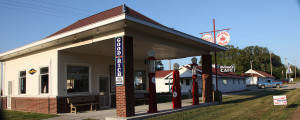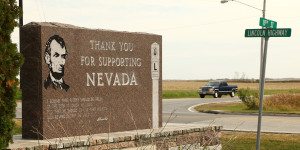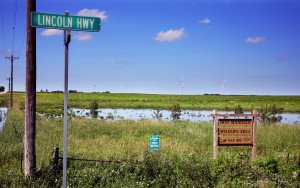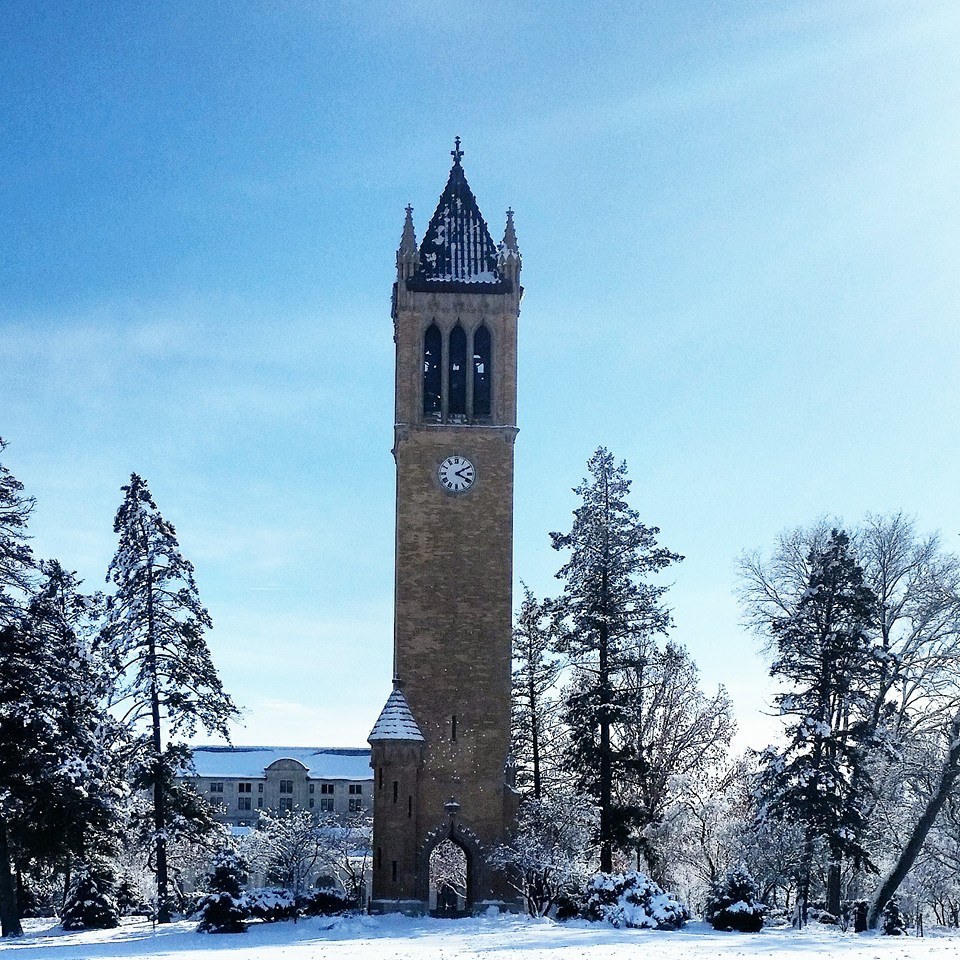Story
Story County
Story County is in the prairie pothole region of the last glacier in the Wisconsin Drift (Thumb Glacier). The Thumb pushed rock, soil, and debris towards Des Moines where it was deposited on the moraine at the location of the State Capitol Building. The glacier went as far as State Center to the east and to Carroll in the west. As the glacier melted and retreated, rivers and streams were formed and the area within the thumbprint became prairies with very tall grass and boggy, swampy areas with tall cattails, water lilies, and marsh grasses. As this, plant material died in the winter and decayed because of this, very rich soil, which would be good for raising crops, was created. Therefore, Story County was originally open prairie except for groves along the larger streams when the early settlers arrived. The Skunk River, in the early days, was much smaller and bordered by nearly impassable bogs. Indian settlements preferred the Des Moines, Cedar, and Iowa Rivers which were 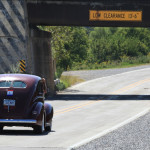 better for hunting fishing and canoe transportation. Early settlers found it to be an expanse of land of shallow streams with wide bottoms and natural areas with very imperfect drainage. The early settlers found the driest land to build and settle.
better for hunting fishing and canoe transportation. Early settlers found it to be an expanse of land of shallow streams with wide bottoms and natural areas with very imperfect drainage. The early settlers found the driest land to build and settle.
The boundaries of the county were established in 1846 and it was named after Joseph Story, a pre-eminent US Supreme Court Justice in 1853. Three commissioners were appointed by the state legislature to travel to the county and locate a suitable location for the county seat. They selected the site where the town of Nevada is located and today there is a small marker at the Story County Administration building noting the site. The first settlers were mainly from Indiana, New York, and Pennsylvania. Later Norwegians, Germans, and Danes came directly from overseas.
Towns along the Lincoln Highway
Colo
The town of Colo was incorporated on April 26, 1876. One legend states the name Colo came from a railroad official, John Blair, who named the community after his dog. Colo is fortunate to the Jefferson Highway coming from Winnipeg, Manitoba, Canada to the north and the Lincoln Highway travelling east/west through it. The two highways originally were conjoined and traveled west until the Jefferson turned south at Nevada and headed to New Orleans, LA.
At the intersection of the two roads, a gas station, cafe, and motel sprung up. Today it is known as the Reed-Niland Corner and beside the operational cafe and motel, there is also a museum. To the west of town, is the Colo Bogs. As some Iowa land farmers attempted to drain it, but it has now been returned to a wetland. It drains into the Iowa River, east of Marshalltown in the next county over, Marshall County.
Colo celebrates with the Crossroads Festival every July. To the south, near the new Highway 30, the Story County Conservation oversees Hickory Grove Park, a 445 acre park that includes a 98 acre lake. Fishing, swimming, canoeing, picnicking, and camping is allowed at the park.
One of the Commissioners to decide the county seat location, Joseph Thrift, named the town for the Sierras Nevada, the “Eldorado of the Rocky Mountains”. The first settler was T.E. Alderman, then the McLain family, followed by the George Child family. The Child Family Log Cabin, the third home in town, is now owned by the Nevada Historical Society and after being moved to several sites over the years; it has been relocated to 1204 H Ave, at the Briggs Terrace (Evergreen Lane) complex. Prairie grass has been allowed to grow around it for visitors to enjoy.
The Briggs Terrace complex is an 8-acre site that once was a working farm. It has a Victorian home, carriage house, and several outbuildings. Otis Briggs was a banker and his daughter, Lida, married into another banking family, the Dutton’s. Otis gave the property to the newlyweds and Jay and Lida Dutton renamed it Evergreen Lane. Today, the one-room Halley schoolhouse has also been moved to the property as it was not on its original site and could add to the interpretation at the complex. The property is on the National Register of Historic Places as it the downtown of Nevada.
The Historical Society also has the Dyer-Dowell House, the first jail in Nevada and now a Victorian home. They also have a museum in the downtown area.
Outside the Story County Administration building on 6th St (Main Street) not far from the marker commemorating the town’s formation, is a cannon used in the Civil War and given to the Nevada Grand Army of the Republic, Jason Ferguson Post #31. When it was being unloaded from the rail car, the barrel slipped and it killed the man unloading it. On Armistice Day in 1918, it was fired for the last time when a stranger gave the townspeople tips on loading it and due to his advice it fired prematurely and the ramrod went through a young man’s chest.
The south side of Nevada was once the home of the Seventh Day Adventist’s school. Children from across the state and surrounding states came to the K-12 school and the children lived in dormitories. The school has now closed and the teacher’s homes have been sold, but the congregation still has a church in town. In the early years, many Danish lived in the north part of town and they built a Dane Hall that was used like a family youth center for members.
Nevada was the second town in Iowa to install wind turbines. The first ones were given to the school and hospital by a local banker. Today, several more dot the skyline.
The community was named for Oakes Ames, a Congressman from Massachusetts with railroad interests. The first business was operated out of the railroad depot. In 1865, H. F. Kingsbury was the station agent, express agent, and postmaster. He added a small stock of groceries to the depot.
Streetcars carried passengers between downtown Ames and the campus on the steam powered Ames and College Railway (The Dinkey) from 1891-1907 and on the Fort Dodge, Des Moines and Southern railroad electric trolley, interurban line from 1907-1929.
Famous people from Ames include: Billy Sunday- a professional baseball player and evangelist, George Washington Carver- plant scientist, John Atanasoff- inventor of the first electronic digital computer, Neta Snook- pioneer aviatrix and teacher of Amelia Earhart, Ada Hayden- prairie scientist, Nick Nolte- Hollywood actor, Art Fry- inventor of the Post-it Note, and Ted Kooser- US Poet Laureate and Pulitzer Prize winner In poetry. Actually Nevada also claims Billy Sunday as he was raised on a farm between the two towns and as his widowed mother could no longer care for him and his brother. At the age of 12 he was sent to an orphanage. When he turned 14, he had to leave the orphanage. He returned to the area and found employment with Colonel John Scott in Nevada and lived in his home. At the age of 18, he moved to Ames and was employed there. Later he moved to Marshalltown where his baseball career took off.
Ames is home to many parks. The most notable are the Ada Hayden Park at 5205 Grand and the County’s McFarland Park on 56461 180th Street. McFarland Park is 200 acres with a tall-grass prairie, woodland and streams habitats. Ada Hayden Park includes a walking path, bike path, boat access, nature area, boating for electric motors only, and allows fishing.
Iowa State University
The Iowa Agricultural College and Model farm was established on March 22, 1858 by the Iowa Legislature. The original farm was 648 acres. The Farmhouse, the first building, was completed in 1861. In 1862, Iowa voted to accept the provisions of the Morrill Act, which was awarded to the Ag College. In 1864, as a land grant institution, the college focused on ideals that higher education should be accessible to all and the university should teach liberal and practical subjects. Even before the Smith-Lever Act of 1914, which established the Cooperative Extension Service, Iowa State was bringing knowledge to the people of Iowa through farmer short courses and farm demonstrations.
The first class graduated in 1892. Today the school is a leader in agriculture, engineering, extension, and home economics. ISU created the nation’s first veterinarian school in 1879. In 1959, the official name became Iowa State University of Science and Technology.
Many of the buildings on campus are on the National Register of Historic Places. Taken from Iowa State’s historical website.
Of importance is the Reiman Gardens. Iowa State has had a horticulture garden since 1914 and has moved it several times due to space constraints. In 1994, Ray and Bobbi Reiman gave $1.3 million dollars to construct a new garden on five acres. The site includes the Herb Garden, Rose Garden, the Campanile Garden, Mahlstede Horticulture Learning Center and a Maintenance Building, the Children’s Garden, the Town and Country Garden and Lake Helen. The gardens have increased to 17 acres with the most recent addition of the Conservatory Complex and Christina Reiman Butterfly Wing.
Story County and The Lincoln Highway
The Lincoln Highway had its problems in Story County as it had to travel across rivers, creeks, and boggy spots. One of the most famous pictures on the Lincoln Highway is a car trying to make it through the area where the Colo Bogs are now located. In 1918, Nevada paved the section that went through town. It wasn’t until 1929 that the bond issue passed (third time voting) and the rest of the road in the county was paved.
Story County Skyline
It is not a town, but a traveler to the area might notice the wind turbines that grace the sky north of Colo. The NextEra Energy Resources company has 200 wind turbines placed in Story and Hardin County. The 300 megawatt wind generation plant uses no water, allows the land around them to still be used for agriculture, and does not cause air or water pollution as it creates electricity. The turbines were installed in 2008 and 2009. They work like a child’s pinwheel. The weather station at the top tells the wind speed and direction to the computer inside and the blades will be turned to always face the wind. As the wind turns the blades, cables carry the electricity down the turbine to the substation, then to the transmission lines, to the local utility and eventually to the customer. The turbines stand 262 feet from the ground to the hub center in the middle of the blades. This wind farm can power 75,000 homes. Next Era Energy Resources.
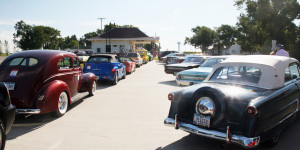 Other towns in Story County
Other towns in Story County
Cambridge was incorporated in 1856. By 1882, the community offered a circulating library. For a $3 share, you could have free use of a book for two weeks. The town is part of the Ballard School district and has a new elementary school. The town celebrates Skunk River Valley Days on the 2nd week in June and the Fall Fest in October.
Collins was once called Plumb Center after James Plumb who had a store there. Then it was changed to Collins Center after a township in NY or for Rev. Collins, from Ohio. The name was later changed to just Collins. Collins Days is the 4th weekend in June and offers a parade, food, and fireworks.
- Fernald
As an unincorporated town, Fernald is home to two grain elevators. It once had its own school and the year book was called the White Hawk. Today, it is included in the Nevada mail delivery and the Nevada school district.
The town was named after George Gilbert, who owned the land it was built upon. It once had an airport and a stockyard. See Gilbert’s historical society website for more information about the town’s museum.
In 1881, S.S. Merrill platted the village and named it after his uncle and British biologist Thomas Henry Huxley.
The post office was established here in 1875 and remained in operation until 2013. The town was named for J.T. Kelly, the landowner. The settlers had Scandinavian roots and a popular restaurant from 1953-1988 was the Fjord. The female staff wore Norwegian vests and skirts. The menus were hand-printed and the dinnerware and napkins were in Norwegian design. The building was torn down to make room for the Dairy Queen and new hardware store. Kelly has one of the few remaining phone booths in the country and many young people use it as a photo op.
Old Settlers Day is the first weekend in August. The festivities include a parade, rodeo, carnival, and live music. The Story County Freedom Rock will be completed in 2015 in Maxwell. The Maxwell Museum has over 10,000 artifacts in 3 buildings. Visit Maxwell’s city website for more information.
The station here was first called Boardman by a construction company. Then it changed to Latrobe. Two men – McCall and Boardman -agreed for one to pay the other to rename it. McCall chose “Sinclair” and Boardman chose “Gookin” (his mother’s maiden name). The men decided on “Sinclair”, but that was unacceptable to the railroad officials, so it was named McCallsburg.
Torkel Henryson, a young teacher in Norway, gathered a group of people in 1846 to immigrate to America. This included 165 people, comprised of 29 families and 15 single people. They charted a sail sip on May 11, 1847 leaving Bergen, Norway for New York. From NY they travelled to Chicago and then by ox-drawn covered wagons to Lisbon, IL. Finding no government land available to purchase and private land too costly, they felt perhaps they should go to the land west of the Mississippi as it had just opened up to settlers. They sent an advance team and they found land in Story County to their liking east of the James Smith home which was 1 mile east and 1 mile south of present day Story City. Procuring large government tracts for $1.25/acre and smaller private land at $10/acre, the advance group returned to Illinois. In May 1856, a caravan of 18 covered wagons set out for Story County, Iowa. They arrived in mid-June of that year. More Norwegians came from Illinois and Norway. Log cabins were built along the Skunk River and a few dug caves to live in until their homes were built. In 1870, the first post office was housed at the Jonas Duea farm. In 1881, the Iowa Central Railroad came through and the town was finally incorporated in 1891. The town was given its name by postmaster John Evenson as he thought it was easy to pronounce in English and Norwegian and would be easy to spell. There are 2 Lutheran churches in town, with the original buildings going up in 1874 and 1868. Electricity came to the community in 1911.
- Sheldahl
This small town lies in Boone, Story, and Polk County with Polk being the controlling county. In 1855, 120 Norwegian immigrants came from Lisbon, IL and the community was incorporated in 1891.
In 1883, the Chicago and Northwestern railroad and the Chicago, Milwaukee, and St Paul railroad built a crossing 1 ½ mile north of Sheldahl with regular trains scheduled. The state required a depot be built at crossings, so one was built at the southeast edge of the crossing and it was called Sheldahl Crossing. Small settlements sprung up around the depot. At one time as many as 10 passenger trains made daily stops. Over the next 5 years, 50 homes and businesses moved from Sheldahl to Sheldahl Crossing. Structures were moved in their entirety. It was renamed “Slater” and incorporated in 1890.
The first settlers were from Scandinavia and arrived in the Story City area, settling near the Skunk River (then called Chicaque). They found the area to have access to water and timber. The town was first called Fairview. The Norwegians settling there found the town to be small and insignificant until after the Civil War. The Des Moines and Minneapolis Railroad came through in 1879. Having a rail line could spur a local commercial boom, as it was preferred over the mud-ridden roads to Ames and Gilbert. The Northwestern going east and west came through in 1881. By then, the community needed to establish a post office, but discovered the name Fairview was already taken. The name was changed to Story City after the same US Supreme Court Justice the county was named. New residents located away from the river. The town was mostly Norwegian and built 3 Lutheran churches. The newspaper was also written in Norwegian.
Today the town celebrates Scandinavian Days the first weekend in June. In 2015, it was the 50th year for the festival. Located in the North Park along the Skunk River is a 1913 Herschel-Spillman antique carousel with wooden figures – 20 horses, 2 chickens, 2 pigs, 2 dogs, 2 chariots, and a whirling tub. A 1936 Wurlitzer plays calliope music.
The town also has several museums. See their website for more information.
The prairie grass once was so tall it could hide animals like herds of elk and deer. Early settlers plowed the land one year and planted it the next. The railroad came through in 1881 and it was proposed to locate a town in Lincoln Township. The railroad man, Mr. Ash, suggested the land of Charles Hurst and the town would be named Ashurst for both men. The site and name were disputed by the residents in the area and it was renamed Zearing after William Mitchell Zearing, a judge from Chicago who donated a bell to the first church in the community. He never did set foot in the town. The town was founded in 1881 and incorporated in 1883.
The Lincoln Township Mausoleum is on the National Register of Historic Places and lies at the north end of town. Dakins Lake is on the north side of E-18. In anticipation of the opening of the park in 2015, there were 4500 fish released into the lake.
Zearing hosts Zearing Days in July. See the Zearing Days’ website for details. The most widely known resident was the late Dick Sparrow, whose 40 horse hitch graced many parades and events, including the Rose Parade.

